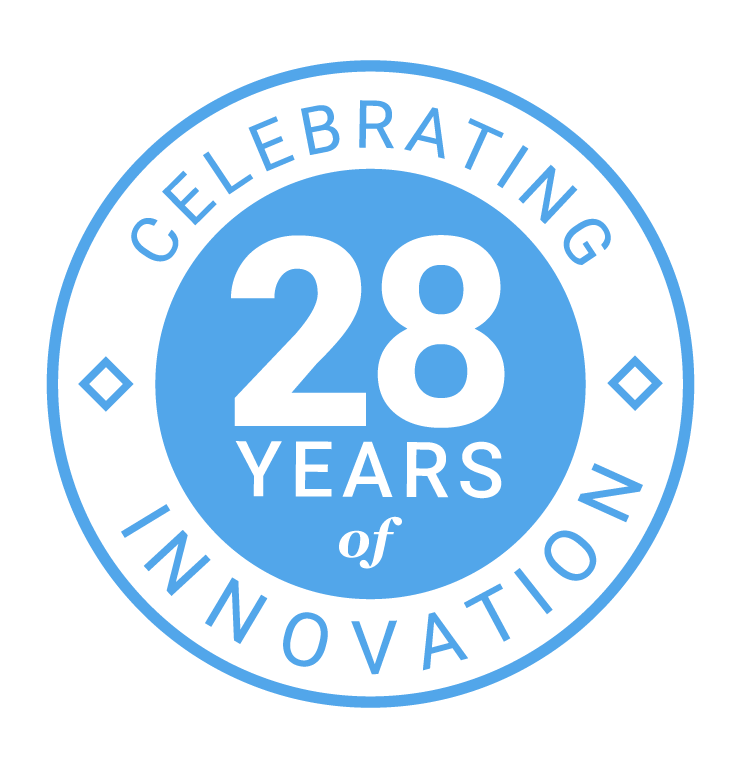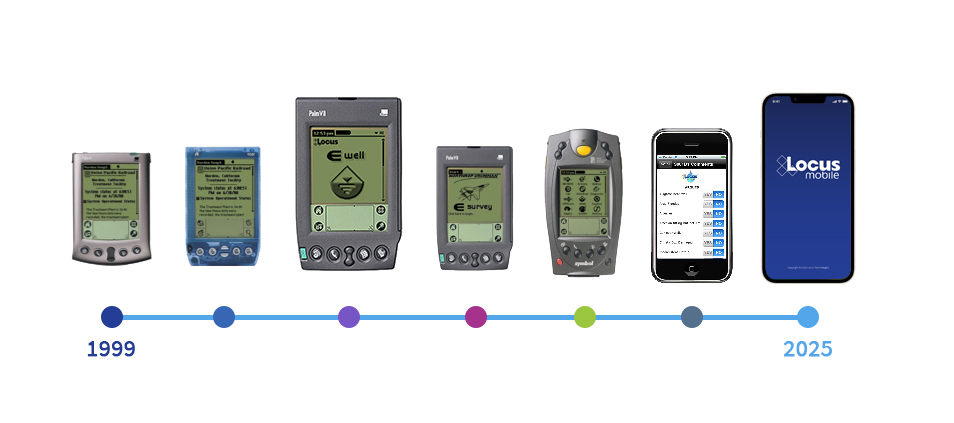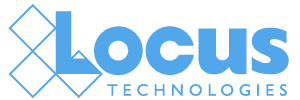Locus Technologies officially opened for business in Silicon Valley on April 11, 1997. In the dynamic tech industry, thriving for 28 years is especially remarkable. While some brands like PalmPilot, for example, come in hot and burn out early, others follow the iPhone trajectory. So why do some companies flourish long-term while others fizzle?

At Locus, we owe our longevity to incredibly talented professionals, many of whom have worked with us for decades, and to several technical differentiators.
As we watch other EHS&S software vendors come and go, and we help enterprises transition away from now-defunct third-party products, we are reminded of the market predictions made by Locus in 1989 and the subsequent strategic engineering decisions made in 1997 that enable Locus to weather every storm.
For example, our founding team accurately predicted that explosive growth in the nascent environment industry would drive the development of specialized software and artificial intelligence engines to manage and interpret the forthcoming data avalanche. Their prophetic, strategic visions were published by Civil Engineering Magazine and the American Society for Civil Engineers1, inspiring industry innovation – some of which capitalized on the technical advancements emerging at that time.
Before we dive into the defining attributes that have enabled Locus to thrive since 1997, let’s explore our virtual time capsule of other technical debuts from that same year.
1997 Time Capsule
This was a pivotal year in tech, marking the release of several iconic products and applications that helped shape the modern digital world. Here’s a list of some notable launches from that year. Some brands are short timers. Others stand the test of time.
- PalmPilot Personal Digital Assistant (PDA) became hugely popular in 1997. It was a breakthrough product for personal organization, allowing users to store contacts, calendars, and notes on a small portable device. This marked a major milestone in the evolution of mobile devices.
- Sony PlayStation was launched in North America in 1997, quickly becoming one of the most successful video game consoles in history.
- TiVo launched in 1997, revolutionizing the way people interacted with television content. The first commercial DVD player was released that same year and soon replaced VHS as the dominant home entertainment medium, with better video and audio quality.
- In 1997, the dot-com bubble began as VC-funded startups sought to ride the wave of internet excitement. Internet Explorer 4.0 and Netscape Navigator dominated as the web was becoming a crucial platform for communication, business, and entertainment.
- Amazon launched its e-commerce website for books in 1997 and quickly expanded to become one of the world’s largest online retailers. The Google.com domain was registered on September 15, 1997.
- Dial-up internet access was still the norm for most consumers, with companies like AOL and Prodigy offering internet service, online content, instant messaging, and email services. The early days of broadband were on the horizon but not yet widely available.
- Microsoft purchased Hotmail in December 1997, bringing web-based email to the masses and launching the trend of cloud-hosted consumer services.
- Java began to gain real traction in 1997 as a platform for building web applications and enterprise-level software. Java’s “Write Once, Run Anywhere” promise made it appealing for developers targeting multiple platforms.
- Apple iMac was announced in 1997 by then-CEO Steve Jobs, marking a major shift for the company. The iMac would later go on to become one of Apple’s most iconic products.
- Client-server computing was still a dominant model in enterprise IT architecture, with businesses utilizing client computers to interact with centralized servers running software and databases.
- While Software-as-a-Service (SaaS) was not yet mainstream, some early signs of the model were emerging as companies like Salesforce and WebEx were pioneering web-based software delivery. This marked the beginning of a shift from traditional software licenses to subscription models.
- IBM Deep Blue became the first computer system to defeat a reigning world chess champion in a match under standard chess tournament conditions – a milestone for AI.
Celebrating 28 years of masterfully riding the wave of progress

Locus may be an incredible 196 in ‘tech years,’ but the following technical attributes – which were driven by those fateful strategy meetings three decades ago – keep us spry and agile as the market evolves.
Locus is 100% cloud-native, multitenant software-as-a-service.
As indicated by items 10 and 11 in the time capsule, 1997 presented a strategic crossroads for software development companies: either trudge down the worn path of client-server architecture or be bold. Like Amazon and eBay, Locus chose to be bold. And that gamble paid off. While other EHS&S companies try and fail to retrofit their client-server products for the cloud, Locus has been entirely cloud-based from the get-go. Our company’s fateful choice from 1997 has had a significant impact every day: the latest functionality and security fixes are continuously delivered to our clients’ desktops and mobile devices.
With Locus: No interruptions. No cumbersome upgrades. No IT burdens. No frustration. The others can’t say the same (which is why some might follow the Tivo and AOL path).
Locus software is fully integrated.
Apple might be the ultimate archetype of integration, interoperability, and resilience. Similarly, Locus supports an ecosystem of 30+ apps, each of which resolves specific challenges for EHS&S professionals. Our clients mix-and-match individual apps to create their ideal, fully integrated EHS&S solution. Enterprises move their EHS&S programs to Locus once they discover other products don’t work together as claimed. Plus, the use of artificial intelligence is impeded by others’ fractured systems and data siloes.
With Locus: No compatibility issues. No redundant data. No obstacles to AI. The others can’t say the same (which is why they might eventually fade away).
Locus apps are metadata driven.
This might be the coolest and most enduring aspect of Locus software. Business priorities and regulatory requirements could change overnight, so what about your software? Just as Salesforce gives its clients a robust platform with vast options for configurability and companion apps, Locus enables power users to “make it their own.” Locus software was engineered to be metadata driven, which makes all domain-level content, like business logic, interfaces, forms, and reports editable. So, the next time your priorities or requirements change, so can your software. This same strategic engineering decision means that Locus clients can create their own drag-and-drop apps to resolve emerging business challenges.
With Locus: No captivity to obsolete software. No messy workarounds. No waiting for new versions to be released. The others can’t say the same (which might explain their fizzle).
Enjoying the road less traveled
Way back in 1997, at that critical crossroads in technology, Locus chose to pioneer cloud-based environmental software. Our company was among the first to embrace a multitenant SaaS architecture, enabling continuous upgrades and seamless scalability.
Unlike many peers who chose short-term growth or built inflexible, siloed systems, Locus remained committed to a unified, configurable platform that could evolve with changing regulations and customer needs. This long-term vision, coupled with a strong culture of customer retention and product integrity, has allowed Locus to remain independent, adaptive, and trusted across decades of regulatory and market shifts. And that is precisely why so many great companies selected—and have stayed with—Locus for decades, including Chevron, ExxonMobil, Port Authority of NY & NJ, U.S. Department of Energy, DuPont, Corteva, Chemours, Port of Seattle, Foster Farms, PSEG, PG&E, and many others.
Looking ahead
Locus Technologies’ longevity—serving customers continuously for over 28 years—stands as a rare achievement in the environmental and EHS software space, where many better-funded competitors have failed, exited the market, or been acquired. What sets Locus apart is its unwavering focus on technical excellence, customer-centric innovation, and disciplined financial management.
In our next chapters, Locus will continually adapt to new realities and new challenges. For example, our new Refrigerant Management app is gaining momentum and helping organizations track inventories and manage the phasedown of high-GWP refrigerant gases. As we see PFAS regulations expand, Locus has reached a significant milestone, becoming the largest global database of 3 million PFAS records from nearly 40,000 locations. And to help utilities, governments, and enterprises respond to increasing pressures to protect water supplies, our developers are expanding our collection of purpose-built water apps.
In our view, this responsiveness to the market, coupled with our technical attributes, position Locus to be “more iPhone, less PalmPilot.”

Locus is the only self-funded water, air, soil, biological, energy, and waste EHS software company that is still owned and managed by its founder. The brightest minds in environmental science, embodied carbon, CO2 emissions, refrigerants, and PFAS hang their hats at Locus, and they’ve helped us to become a market leader in EHS software. Every client-facing employee at Locus has an advanced degree in science or professional EHS experience, and they incubate new ideas every day – such as how machine learning, AI, blockchain, and the Internet of Things will up the ante for EHS software, ESG, and sustainability.



